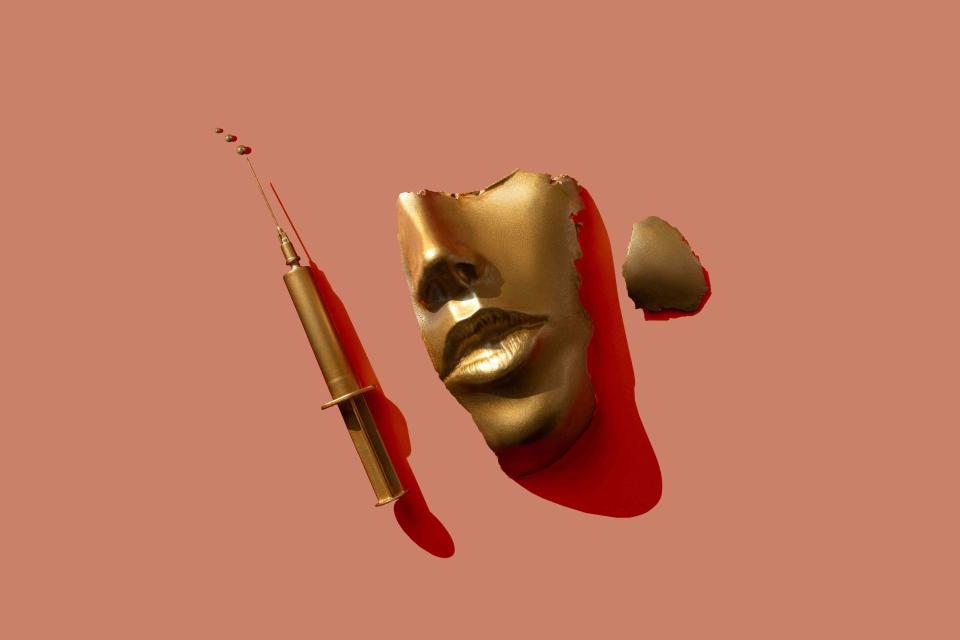Everything You Need to Know About Getting Under Eye Filler
From risks and cost to (realistic) expectations.

Yulia Reznikov/Getty Images
We live in a world where you can erase deep wrinkles with swift injections, get glowy skin from some laser zaps, and add volume to your face in a matter of minutes. While these medical aesthetic advancements are impressive, effective, and generally considered safe, it’s still important to weigh all the pros and cons—and do lots of research—before booking an appointment.
Under eye fillers are a gray area (no pun intended) in the world of injectables, with some experts singing their praise while others saying you should heed caution. We spoke with a handful of experienced skincare professionals to learn more about the potential benefits and risks of under eye filler, costs, maintenance, and whether the treatment is worth it in the first place.
RELATED: A Complete Guide to Botox: Everything You Need to Know
Meet the Experts
Robert Schwarcz, MD, a double-board certified oculoplastic surgeon based in New York City
Shawnda Dorantes, APRN, MSN, FNP-C, an aesthetic nurse practitioner at Beauty Lounge Medical Spa in San Diego, Calif.
Kami Parsa, MD, a board-certified oculoplastic and reconstructive surgeon in Beverly Hills, Calif.
What Does Under Eye Filler Do?
Under eye fillers are a dermal filler, typically consisting of hyaluronic acid, that are injected into hollow areas under your eyes, including tear troughs or orbital hollows. The goal is to restore lost volume, create symmetry, and reduce the appearance of dark circles or sunken, hollow eyes. They can also smooth the area and minimize fine lines.
“There are a variety of dermal fillers, including Sculptra, Belotero, Radiesse, Restylane and Juvederm,” notes Shawnda Dorantes, APRN, MSN, FNP-C, an aesthetic nurse practitioner at Beauty Lounge Medical Spa in San Diego, Calif. “The patient and provider decide which is best for the individual patient during the initial consultation with an expert injector.”
Is Under Eye Filler Safe?
Yes, but with caveats. With a highly skilled injector and the right candidate, under eye filler is considered safe and effective. In fact, there are several hyaluronic acid dermal filler products that have FDA approval for usage in under eye hollows, and the treatment is considered on-label, notes Kami Parsa, MD, a board-certified oculoplastic and reconstructive surgeon in Beverly Hills, Calif.
Robert Schwarcz, MD, a double-board certified oculoplastic surgeon based in New York City, agrees. However, he says, “Even if they are on label, people should proceed with caution as this is a very delicate and complex area to address. You need someone highly skilled in the anatomy of the eye.”
Benefits
Minimally invasive
Lasts up to a year
Reduces dark circles in ideal candidates
Lends a youthful look in ideal candidates
Risks
Bleeding, bruising, and swelling (short term)
Results typically fade away after a year
Vascular occlusion
Overfilled look
Exacerbated issues if you’re not an ideal candidate
Risks are minimized by seeing a board-certified oculoplastic surgeon that specializes in the eye area for these types of treatments.
Who’s a Candidate for Under Eye Filler?
Not everyone is a candidate for under eye filler. It’s important to speak to medically trained experts to determine whether this is the right treatment approach for your concerns, be they dark circles, wrinkles, or hollowing.
“The best candidates are patients with true tear trough hollows who are not interested in a more surgical and permanent options like fat transfer or lower eyelid blepharoplasty,” Dr. Parsa says. “Also, the best candidates don’t have eye bags, do not retain fluid—[medically referred to as] malar edema or festoons—do not wake up with eye bags that fluctuate throughout the day, and do not have significant crepey skin around the eyes.”
Any of the above issues should be addressed differently since under eye filler can potentially make them worse. Dr. Schwarcz adds that ideal candidates are generally people who are younger with good skin quality and don’t have much pre-existing fat. They’ll most often see the best results.
For those who aren’t an ideal candidate, Dr. Schwarcz says that better options resulting in a more natural, desirable look include a blepharoplasty (eyelid lift), which can be combined with fat grafting and other modalities for “a long lasting, very natural result.”
Under Eye Filler Cost
The cost of under eye filler varies depending on the patient. However, the average cost of under eye filler is around $1,000 to $2,000 for both eyes. Dorantes says you can expect results to last anywhere from six to 12 months depending on the type of filler used and your unique metabolism.
What It’s Like to Get Under Eye Filler
Prior to any injections, you’ll need to consult with an expert injector to determine whether you’re a candidate for under eye filler. If you’re given the green light, then you’ll head into your appointment and the area will be cleaned, prepped, and free of makeup.
“Injections have minimal pain and most treatments are done in less than 15 minutes,” says Dr. Schwarcz. “There is very little downtime after an eye filler treatment; most patients go right back to work or their regular activities.”
You may feel tender in the area, but shouldn’t experience pain. To soothe the area, you can apply a cool compress immediately after, that evening, and the next morning. Otherwise, Dr. Schwarcz says to avoid heavy exercise, alcohol, and blood thinning medications such as ibuprofen for the next 24 to 48 hours.
For more Real Simple news, make sure to sign up for our newsletter!
Read the original article on Real Simple.


